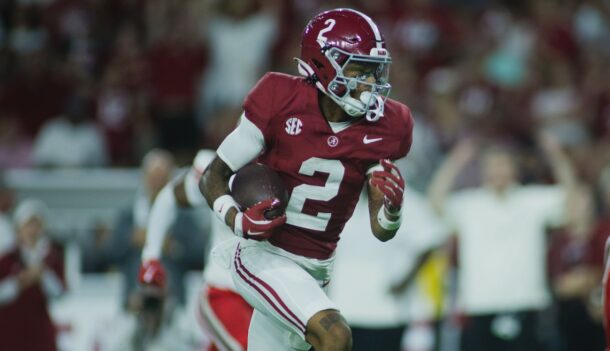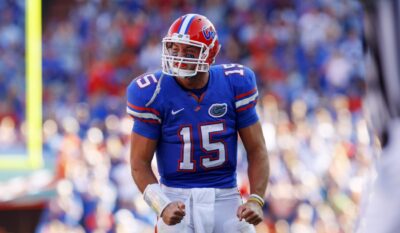This is an oversimplification, as recounting complex history in tidy fashion so often is.
But more than any other factor, the SEC launched the massive college football realignment in the early 1990s — the same realignment that’s just now starting to settle.
The SEC wanted to take advantage of a little-known NCAA bylaw that allowed conferences with 12 members to split into divisions and stage a championship game. The process by which conferences negotiated TV rights was changing dramatically, and the SEC knew such a championship game would be a big deal as it tried to sell itself to major networks.
In addition to logistics, it made sense for the conference to expand its geographic footprint — into Southwest Conference territory in Texas and Arkansas if possible. The SEC appeared to covet a monopoly in Florida as well, entertaining the fantasy of owning all three major football programs in the Sunshine State.
Big East commissioner Mike Tranghese, in what would become a chillingly accurate prediction, warned league presidents that football was a necessity: “If they weren’t prepared to get Miami, and build a base for other football schools, we were going to be out of business. It was that simple.”
Notre Dame withdrew from the College Football Association in February 1990 and negotiated its own contract with NBC. With all of this in the background, the SEC decided to make a power play.
Feeling threatened, the SWC circled its wagons, especially in Texas. And the ACC, which publicly downplayed its desire to expand, eventually courted Florida State hard.
The SEC came across as entitled. Retrospectively, the conference acted as if FSU would automatically say yes if asked to join. Seminoles coach Bobby Bowden did not want to face the likes of Alabama, Auburn and Florida in the same season, and the SEC wouldn’t budge on realignment logistics.
The ACC could offer a lucrative basketball purse, and fewer members meant splitting conference revenue with fewer partners. Bowden openly admitted he preferred the ACC to the SEC due to the ferocious competitiveness of the latter.
According to the Los Angeles Times, circa September 1990:
Gracious losers that they are, the SEC athletic directors voted last week not to extend mighty Florida State an invitation to join. Of course, they did this after they learned the Seminoles had committed to the ACC.
Then, completing the classless farce, Louisiana State Athletic Director Joe Dean suggested that Florida State would regret the day it spurned the SEC. Dean went so far as to say that SEC teams should consider banning the Seminoles as future opponents.
As one might expect, few tears were shed for the SEC.
“The SEC was so aggressive, so overly aggressive, that it caused other conferences to defend themselves,” said Fred Jacoby, Southwest Conference commissioner. “They’re acting like a jilted lover, a jilted suitor. (The vote) was a face-saving technique.”
If the SEC had handled the communication a little differently, perhaps Florida State would’ve joined the SEC. At the time, it turned into a tremendous move for FSU, which indeed dominated ACC football at an almost unprecedented level for years to come.
But isn’t it fun in sports to ask “what if?”
The Florida State Dominoes
1. Bobby Bowden would not have lasted until 2009 as head coach
The Seminoles lost 4.75 games per season from 2002-09 as Bowden faced increasing internal pressure to step down. (The NCAA later vacated several results in ’06 and ’07 due to ineligible FSU players.)
Bowden led FSU to an amazing 14 consecutive Top 5 finishes in the Associated Press poll. Nick Saban has five such finishes — combined — for his career.
But the program started to slip a bit after the Seminoles lost the 2001 BCS Championship to Oklahoma, 13-2.
Consider that FSU is 18-14-1 against SEC opponents since joining the ACC in ’91. Those years, ’02 to ’09, coincide with the rise of the SEC, overlapping the seven consecutive national titles. Suddenly those FSU seasons, which hovered around 8-5, could’ve been more like 7-6 or 6-7. Even a legend like Bowden can’t afford two or three consecutive seasons like that in the pressure cooker that is the modern-day SEC.
Jimbo Fisher became the Seminoles’ head coach in waiting prior to the ’07 season. If Bowden had left in ’06 or ’07 would FSU have hired him? And if so, Urban Meyer’s Florida teams were very good during the next few years. Would the Gators have stunted Fisher’s growth as a head coach with some big early beat-downs?
2. Florida State doesn’t make the College Football Playoff in 2014.
It seems impossible that FSU would’ve finished the regular season unbeaten in the SEC in ’14. Not when the Seminoles fought to overcome Oklahoma State, Clemson, N.C. State, Notre Dame, Miami, Boston College and Georgia Tech.
What if FSU had played Alabama, LSU, Auburn, Ole Miss, Mississippi State and Georgia or Missouri instead? The Seminoles, which slipped into the CFP courtesy of their unbeaten record as the defending national champion, probably could’ve afforded one loss due to the bump in schedule difficulty.
But many post-season projections claim FSU would’ve lost three or more games in ’14 with an SEC West schedule. Instead, TCU or Baylor probably makes the four-team field. It’s possible this could’ve created a reseeding, with Alabama facing the Big 12 team in the first round and Ohio State and Oregon playing the would-be national championship in a semifinal contest.
3. The Seminoles don’t win three national championships (’93, ’99, ’14)
If you thought the ’14 FSU team had it easy in the ACC, you don’t remember ’99. An 8-4 Georgia Tech team was the only other ACC school to finish the season in the Associated Press Top 25.
One of Florida State’s toughest games that year was a 30-23 win at No. 4 Florida. Alabama spanked that same Gators team, 34-7, in the SEC championship weeks later. The conference finished the season with seven AP Top 25 teams, including No. 8 Alabama, No. 9 Tennessee, No. 12 Florida, No. 13 Mississippi State, No. 16 Georgia, No. 17 Arkansas and No. 22 Ole Miss.
Let’s take it a step further. Florida State joined the ACC for two main reasons, depending on whom you believe: 1) to dominate the conference on the football field and 2) because the conference was more lucrative financially in the early ’90s.
Forget speculation about whether Florida State would’ve survived the SEC schedule in ’99. Without those two elements working in conjunction, is FSU such a powerful national brand? Would the Seminoles then be able to recruit the likes of Chris Weinke, Peter Warrick, Travis Minor, Anquan Boldin and Laveranues Coles, at least some of whom played for that ’99 team because of FSU’s previous domination throughout the decade?
We’ll never know. But Bowden himself had this to say on the Paul Finebaum show recently:
Did we bury the lead?! Here's another great quote from Bobby Bowden on why Florida State didn't join the SEC. pic.twitter.com/IqwkdLUgHC
— Paul Finebaum (@finebaum) May 12, 2015
4. Jameis Winston would not have won the Heisman Trophy in ’13
Again, there’s a multi-part justification for this conclusion.
Winston compiled his numbers and wins as a true freshman competing against the likes of Clemson quarterback Tajh Boyd, a great college player, Stephen Morris, Tom Savage and Logan Thomas. Yikes.
In the SEC, Winston would’ve been more closely compared to Johnny Manziel — in fact, the two may have played head to head — AJ McCarron, Aaron Murray, Zach Mettenberger, Connor Shaw, and the list continues.
Does anyone remember the Iron Bowl from that season, and how close it was? Missouri and South Carolina finished bowl season as Top 5 teams. Texas A&M and LSU were good enough to scare the likes of Alabama and beat the likes of Auburn, respectively, in ’13.
How would Winston have responded to a loss early in his career? Would FSU, which narrowly beat a lucky-to-be-there Auburn team for the national title, have looked as dominant in the SEC during the ’13 season? Would his accomplishments be the top headline in the conference on a weekly basis when so many other great college quarterbacks put up remarkable games and seasons as well?
I don’t think so.
The SEC Dominoes
5. The SEC’s BCS title streak reaches 8
We’ve already postulated that Florida State’s road to a BCS championship wouldn’t have been nearly so easy in ’13. But if FSU was a member of the SEC, it’s very possible that we could’ve witnessed an SEC vs. SEC game to end the BCS era.
Florida State, Auburn and Alabama finished 1, 2 and 3 in the final BCS poll by a large margin ahead of Rose Bowl participants Michigan State and Stanford. Assuming that by this time FSU would’ve been a member of the SEC East — and beaten out Mizzou for the title, which is far from a guarantee — the Auburn-FSU game would’ve played out in Atlanta in December.
In that case, it’s possible that Florida State and Alabama could’ve met in the final BCS title game (just as the teams would’ve if the BCS still existed in 2014).
At any rate, with FSU in the mix, the SEC probably would’ve entered the College Football Playoff with an unprecedented eight consecutive national titles.
That probably wouldn’t have done much for the conference in the CFP. FSU probably wouldn’t have finished ’14 as one of the nation’s best four teams, and the SEC champion still would’ve needed to beat a white-hot Ohio State. Still, entering 2015, we’d be talking about the SEC trying to win nine titles in 10 years rather than the potential for a third straight season without a national championship.
6. Steve Spurrier becomes LSU’s coach in 2005.
When Spurrier sat on the sideline during the ’04 season, eyeing a possible return to college football, most believed he’d prefer to coach in the South — hopefully the SEC.
It didn’t take Spurrier long to publicly dismiss a return to Gainesville, Fla., to coach the Gators. Three SEC jobs eventually came open that cycle: LSU, Ole Miss and South Carolina.
If Florida State took the 12th slot in the SEC, it’s conceivable that South Carolina would’ve joined the ACC, likely a deterrent to Spurrier taking that job. (Spurrier had coached at Duke, but remember, he coached at Florida for 12 years and also played football for the Gators.)
When Nick Saban left LSU for the Miami Dolphins, the Tigers hired Les Miles. But Miles, coaching at Oklahoma State, went 7-5 with an Alamo Bowl loss in ’05. Spurrier was an SEC legend. Saban left the LSU program in a great spot, and Spurrier could’ve massaged his ego by heading to Baton Rouge and winning a national title with Saban’s players (like Miles did in ’07).
Can you imagine the SEC in ’09 if Nick Saban, Urban Meyer AND Steve Spurrier were commanding three of the best rosters?
7. South Carolina joins the ACC. Fans are thrilled with the 2014 season.
The Gamecocks in some ways lucked into an SEC spot. The SEC would have preferred to recruit Texas or Texas A&M into the conference, but political pressure (fear of retaliation) in the Lone Star State forced both of those schools to remain in the Southwest Conference.
When FSU headed to the ACC and the SEC couldn’t lure Miami, South Carolina was the last school standing.
Playing in the ACC and without Spurrier as head coach, forget about the back-to-back-to-back 11-win campaigns; 7-6 with a bowl win against Miami could be cause for celebration.
An itinerant journalist, Christopher has moved between states 11 times in seven years. Formally an injury-prone Division I 800-meter specialist, he now wanders the Rockies in search of high peaks.







